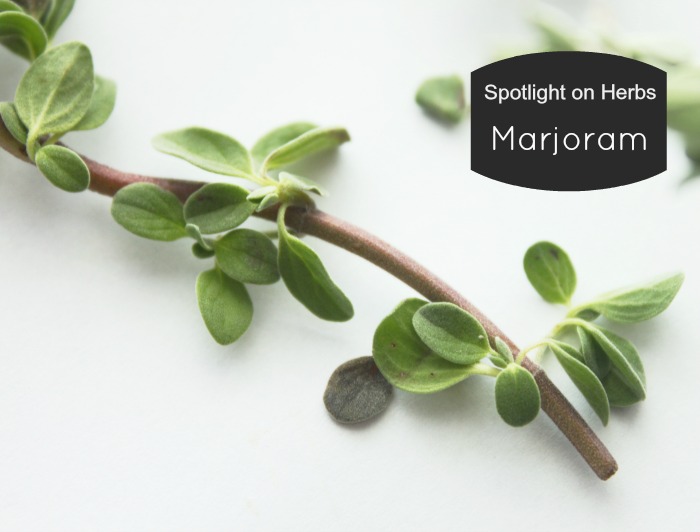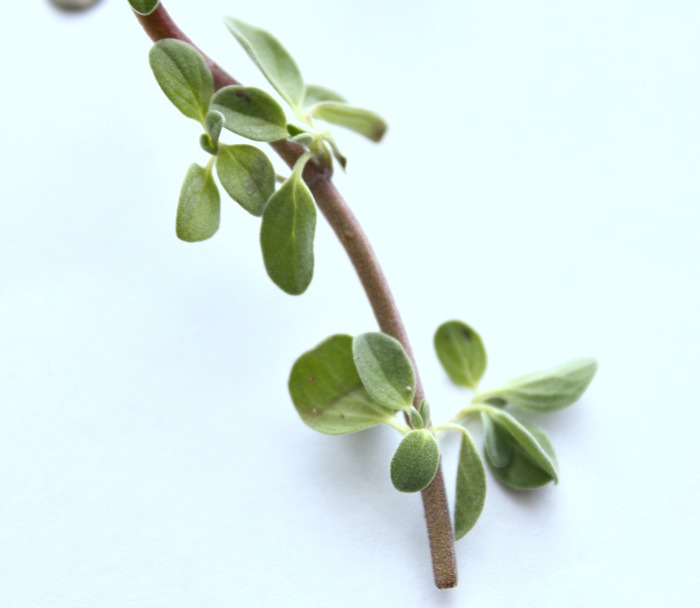
I rarely see marjoram in the spotlight. It humbly takes its place next to showier herbs like borage and bay leaf trees, and the more popular herbs of rosemary and thyme. And yet, year after year, this little plant thrives in both garden and pot. It survives the long winter, basking in the light of a sunny window. With both culinary and medicinal uses, it’s an herb that deserves a second look.
This is the fourth post in our Spotlight on Herbs series.
Growing Marjoram
Although Marjoram can be grown from seed, I like to start it as a seedling so it can make the most of our short growing season. It can be grown as a perennial in zones 8 through 10, or harvested in the fall to then dry and freeze. You can also plant it in a pot and bring it indoors for winter. It thrives in full sun to part shade and prefers well-drained soil with lots of compost. It is a medium-sized plant, growing anywhere between 12 to 24 inches, and will produce little white flowers in late summer if not cut back.
Culinary Uses for Marjoram
- Use as a compliment to meat, especially poultry and sausage (this is another herb I stuff into a chicken or slip under the skin before roasting)
- Use to season lentils, potato dishes, and stew
- Brew in a tea
- Add to pesto
- Pair with eggs, cheese, and creamy soups
- Use in any dish where you would use oregano (they are in the same family)
- Use as a compliment to basil and thyme

Medicinal Uses for Marjoram
Although not the powerhouse that many herbs are, marjoram still has medicinal properties.
- It supports digestion
- It has antiseptic properties which make it helpful in fighting both viral and bacterial infections (great for cold and flu season!)
- Those suffering from anxiety or tension find that it helps to relieve insomnia, irritability, and nervousness
- Taking a bath infused with marjoram can help relieve joint and arthritis pain
You can make use of these properties by brewing it into a tea, creating a tincture, making infused honey, adding it to your favorite foot soak, or throwing it into your bathwater.
For further reading, I recommend Growing Your Own Marjoram from Mother Earth News, Medicinal Herbs by Rosemary Gladstar, and Homegrown Herbs by Tammi Hartung.
Do you grow Marjoram in your garden? What are your favourite ways to use it?
...without giving up the foods you love or spending all day in the kitchen!

2 free books:
Eat God's Way
Ditch the Standard American Diet, get healthier & happier, and save money on groceries...
We only recommend products and services we wholeheartedly endorse. This post may contain special links through which we earn a small commission if you make a purchase (though your price is the same).


Think of marjoram as a sweeter, milder form of oregano, because thats what it is. Same family.
I’m growing some for DIY poultry seasoning- equal parts marjoram, sage, & thyme 🙂
Great tip, Quinn At ReformationAcres!
I use it in soups but I have not really grown it much in my garden. If I recall correctly I used it one season and really enjoyed it. I’m starting to get things around for the spring and would like to get some transplants.
Marjoram is great in Hungarian food. Crispy, buttered fried Oyster mushrooms with Marjoram comes to mind. Lovely.
Wow, thank you! Now that I know all this info, I will try to grow some and use it a lot more!
As much as I love herbs, marjoram is one I haven’t started growing or using much. You make me want to plant some this season!
I’ve read many wonderful things about Marjoram. It should be put around your crops and fruit trees. It attracts beneficial insects that go after harmful insects that damage your fruits and vegetables. It is an aggressive grower like mint. I let it go wild in one area of my yard where it can’t jump to other areas. The rest through out my garden areas I keep in pots and under control
Mints & Oregano benefit cabbage. Marjoram attracts pollinators, benefits cucumbers. Plant under apple trees.http://www.goldmountainherbfarm.com/PollinatorsCompanions.html
Thanks for the tips, Sheri! Mine has never spread beyond it’s little corner of the garden, at least not yet!!
I make marjoram tea for coughs–my grandmother gave it to me for this. It’s tasty and really does help (I add in a bit of honey, too). I do not take it medicinally when pregnant — my old European herbal books have it on the list of herbs to avoid when pregnant. Many, many, many herbs are not recommended during pregnancy and no one ever mentions this. It disturbs me.
Marjoram tea sounds wonderful. And you are right, a large number of herbs should not be taken medicinally during pregnancy. I will be sure to remind women of this in my future herb posts – thank you!